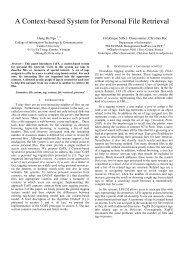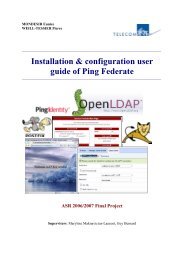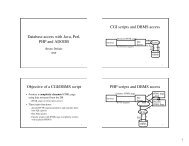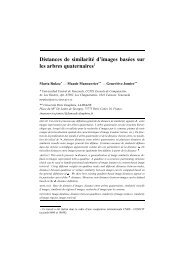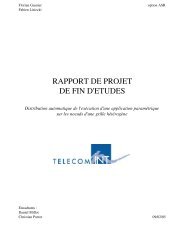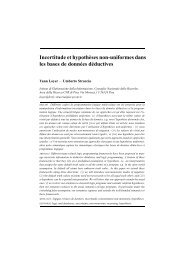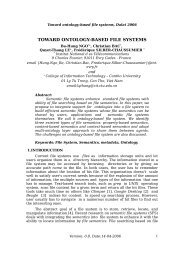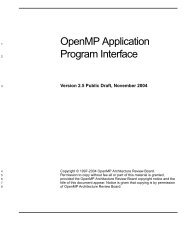Component Search Service and Deployment of Distributed ...
Component Search Service and Deployment of Distributed ...
Component Search Service and Deployment of Distributed ...
Create successful ePaper yourself
Turn your PDF publications into a flip-book with our unique Google optimized e-Paper software.
that supports the trading service in a distributed environment.It can be viewed as an object through which other objectscan advertise their capabilities <strong>and</strong> match their needsagainst advertised capabilities [10]. The trading allows customersto discover <strong>and</strong> select services at run time <strong>and</strong> bindto them dynamically. These services are early exported bysuppliers. In the following, we present some trading systems<strong>and</strong> discuss some <strong>of</strong> their related aspects.3.1. Trading in ANSAThe trading in the ANSA system is defined as follows:the activity <strong>of</strong> choosing services, such that they match someservice requirement. The choice is based on the comparison<strong>of</strong> the specification <strong>of</strong> a service required (provided bya prospective consumer) <strong>and</strong> the service specifications suppliedby service providers or their agents [2]. An ANSAtrader is defined as an object performing the trading activitiesbased on the entire or on a subset <strong>of</strong> the service <strong>of</strong>fers.The trader has not a special status, it is considered like anyother object [2]. A trading service is not the only servicethat can store knowledge about <strong>and</strong> references to other services;on the contrary, any object <strong>and</strong> service can do this.<strong>Service</strong> <strong>of</strong>fers selection is based on conformance <strong>of</strong> servicetype <strong>and</strong> a constraint expression which must characterizethe required service.3.2. Information exchange in UDDIUniversal Description, Discovery <strong>and</strong> Integration(UDDI) defines a framework for publishing <strong>and</strong> discoveringinformation about web services [13]. Consideredservices consist <strong>of</strong> specific business functionalities exposedby companies in order to be used by other companies.UDDI adopts an approach based on the so-calleddistributed registry which includes businesses <strong>and</strong> theirservice descriptions. Built on SOAP (Simple Object AccessProtocol) [14] <strong>and</strong> XML, UDDI intends to ensure interoperabilitythrough a cross-language <strong>and</strong> cross-platformapproach. <strong>Service</strong> description in UDDI must provide threekinds <strong>of</strong> information: white, yellow <strong>and</strong> green (technical)pages-equivalent information, like the OMG specifications[7]. UDDI business registry provides a framework forexchanging service information on Internet. The UDDIregistry is a distributed service with multiple root nodesthat replicate data within each other. <strong>Service</strong> descriptionconsists <strong>of</strong> four types <strong>of</strong> information: business information,service information, binding information, <strong>and</strong> informationabout specifications for services. These types are structuredin a hierarchy <strong>and</strong> correspond to the following entities:¢businessEntity: serves as the top-level informationmanager concerning a business unit. It includes supportfor yellow pages taxonomies (particular industry,product category, geographic situation).¢business<strong>Service</strong>: is a sub-structure <strong>of</strong> the businessEntitystructure. Its role is to keep information relatedto either a business process (purchasing services, shippingservices, etc.) or category <strong>of</strong> services.¢bindingTemplate: within each business<strong>Service</strong> liveone or more technical web service descriptions in abindingTemplate structure (connection address <strong>of</strong> theservice, etc.).To discover a web service using UDDI, the first step isto locate the businessEntity information <strong>of</strong> the service. Theprogrammer can drill down for more detail about a business<strong>Service</strong>or request a full businessEntity structure. Theprogrammer then selects a particular bindingTemplate <strong>and</strong>uses it for contacting the service.As we can see it, the trading in those systems is based onthe notion <strong>of</strong> service represented by an interface. <strong>Search</strong>ingfor service <strong>of</strong>fers requires the use <strong>of</strong> a matching approachwhich allows the trader to select the well-suited service <strong>of</strong>fercorresponding to a requested one.3.3. <strong>Service</strong> <strong>of</strong>fers selectionAn importer uses a trader to search for services matchingsome criteria. A service type, which represents the informationneeded to describe a service, is associated with eachtrader service [10]. It comprises an interface type <strong>and</strong> somenamed property types. <strong>Service</strong>s types can be structured intoa hierarchy reflecting interface type inheritance <strong>and</strong> determiningthe substitution rules between service types.<strong>Service</strong> type conformance allows clients wishing to usea service which they can’t find to substitute it for anotherservice which conforms to the requested one.Conformance in ANSA is based on the no surprises rulein which an interface is substituted for another supportingall its operations. Moreover, each operation <strong>of</strong> the secondinterface exists in the first one with the same name <strong>and</strong>its type conforms. Operation conformance means that theyhave the same lists <strong>of</strong> parameters <strong>and</strong> the same terminationconditions [2].4. <strong>Component</strong> Trading<strong>Component</strong>-based application development requires acomponent description language like IDL3 [9] or CDL [5].This kind <strong>of</strong> languages describes the context <strong>of</strong> components(required/provided interfaces, emitted/received events, etc.)<strong>and</strong> semantic relationships between component specifications<strong>and</strong> implementations (e.g. component £ is equivalent
implies that components must be described in an abstractfashion in order to allow developers to find <strong>and</strong> integratethe appropriate components. They argue that these abstractionsmust be represented in ontologies. Furthermore, theydiscuss interface adapting if the specifications do not matchexactly. Interface adapting consists <strong>of</strong> adapting the outputs<strong>of</strong> one method to inputs <strong>of</strong> another method (adapting oneIDL specification to another).service must be able to distinguish these requests <strong>and</strong> searchfor active component instances rather than for implementationpackages. Figure 3 shows the main components <strong>of</strong> thetool:<strong>Component</strong> <strong>Search</strong> <strong>Service</strong>In conclusion, for a component to be reusable easily, itmust be quickly found <strong>and</strong> understood by developers. Semantictrading which emphasizes on the functionality <strong>of</strong>components contributes significantly to achieve these objectives.5. <strong>Component</strong> search serviceRequestReplyKnowledge BaseTranslator<strong>Search</strong> ToolsNaming <strong>Service</strong>URL LocatorIn this section, we describe a search service we are currentlydeveloping within the framework <strong>of</strong> a project calledCÉSURE. CÉSURE is a project where the objective is toconceive a platform for applications <strong>of</strong> service providedto mobile users [1]. CÉSURE applications are distributedapplications focusing on the mobility <strong>of</strong> users through thesmart card support <strong>and</strong> developed using a component-basedmodel. CÉSURE is intended to provide tools for development,deployment <strong>and</strong> maintenance <strong>of</strong> applications. A number<strong>of</strong> system utilities are developed in this scope. This includescomponent search, monitoring, fault tolerance (componentreplication, failure detection, application reconfiguration,etc.) <strong>and</strong> deployment tools.In CÉSURE, the deployment <strong>of</strong> an application consists<strong>of</strong> searching component packages, active instances<strong>and</strong> hosts on which component implementations must beinstantiated. For example, a user which has subscribedto a weather service, may wish to use his service from amobile terminal. When it connects, the search tool mustsearch for a component corresponding to a man/machineinterface which must be instantiated on the user’s terminal.Moreover, an active component corresponding to a weatherserver must be found by the search tool. Therefore, thesearch tool must be able to search for component packages,instances as well as hosts on which components will be instantiated.5.1. <strong>Component</strong> search service architectureIn this subsection, we present the architecture <strong>of</strong> thecomponent search service which we propose. The aim <strong>of</strong>the service is to respond to component search requests whatevertheir form. In other words, the tool serves as naming<strong>and</strong> trading services at the same time. The semantic tradingis used. Furthermore, since distributed application deploymentmay use already activated component instances, theChoice Policy(preferences, OCL + ...)Trading <strong>Service</strong>Figure 3. <strong>Component</strong> search service architecture.¢Translator: this is the main component <strong>of</strong> the service.It is intended to receive requests <strong>and</strong> reply to theclient (a deployment tool in general). The translatoruses the knowledge base to transform original requestsinto well-suited, easily underst<strong>and</strong>able <strong>and</strong> completerequests using the ontology stored in the knowledgebase. Note that, syntactic <strong>and</strong> semantic informationsare combined in the search process.¢<strong>Search</strong> Tools: they represent the search space. Theyconsist <strong>of</strong> some classical search tools in which servicematching is based on interface type compatibility.This includes CORBA trading <strong>and</strong> naming services, aswell as a tool for locating component packages throughURLs. So, component packages, instances or interfacescan be searched by the same tool. Moreover, thesearch criteria may be a description <strong>of</strong> the entity (componentpackage, service), a symbolic name or an absolutelocation <strong>of</strong> the entity. Following the case, thetrading, the naming or the URL locator is used.¢Knowledge base: the Knowledge-base constitutes abase in which all informations (ontologies) are kept. Inaddition, it includes the matching rules between termsfrom different domains. The matching rules constitutethus an integration <strong>of</strong> ontologies encoding the concepts
¢component behav: expresses the behavior <strong>of</strong> the component.Behavioral information consists, in particular,<strong>of</strong> invariants <strong>and</strong> pre/post conditions. For each componentport (interface), a number <strong>of</strong> invariants maybe specified <strong>and</strong> for each operation <strong>of</strong> the interface,a number <strong>of</strong> pre/post conditions can be defined. Thebehavioral information specification may be expressedin an Eiffel-like language.¢reuse conds: this structure is kept for eventually expressingthe reuse conditions <strong>of</strong> a component. Theseconditions may be inspired from the reuse contractsstudied by De Hondt [4].¢component funcs: describes component functionalitiesin a textual or other form. <strong>Component</strong> importersmay use this possibility to search for some componentby describing its functionalities. When a componentis obtained, its context dependencies including interfacedescription, syntax <strong>and</strong> behavioral conditions areknown. So, the component can be safely used.5.2.3 <strong>Component</strong> search scenarioWhen a request is submitted to the search server, it goesthrough the translator, the heart <strong>of</strong> the model. The translatortransforms the request, rich semantically, to a syntacticrequest, using the matching rules <strong>of</strong> ontologies stored in theknowledge base. The resulting request is then likely to beunderstood in other domains <strong>and</strong> adapted to the traditionalsearch forms.Matching rules stored in the knowledge base <strong>and</strong> resultingfrom ontology integration are used in a dictionary usagemanner. This allows translating terms originating from adomain in another domain. So, requests initiated from adomain can be understood <strong>and</strong> satisfied in another differentdomain, without user intervention.All the search criteria <strong>of</strong> components in the search requestare optional. The search may concern a part <strong>of</strong> a componentdescription. So, clients may provide only a description<strong>of</strong> the component’s functionalities to access the full semantic<strong>and</strong> syntactic characteristics <strong>of</strong> the component. Thisopportunity may be very useful in the development phase <strong>of</strong>applications.6. <strong>Component</strong> search service <strong>and</strong> deploymentThe deployment phase is the last step in the developmentprocess <strong>of</strong> applications. The deployment <strong>of</strong> a distributedapplication consists <strong>of</strong> installing <strong>and</strong> instantiating its componentson the hosting servers, configuring them <strong>and</strong> assemblingthem following the application assembly specification.In many cases, some components used in the assemblyare already active, their instantiation is thereforeunnecessary. The component search service is responsiblefor identifying <strong>and</strong> locating these components. The searchservice is typically used by a deployment tool in order tosearch for appropriate components <strong>and</strong> sometimes to optimizetheir deployment. <strong>Deployment</strong> tools, provided by anORB or other vendors, vary from simple tools which justguarantee the deployment constraints, to more elaboratedtools which ensure more advanced properties, like componentlocation services <strong>and</strong> load balancing.6.1. <strong>Deployment</strong> process in CCMIn CCM, the deployment is intended to hook-up a socalledlogical component topology to a physical computingenvironment [9]. In CCM, the deployment is triggered bylogical component assembly specified in an assembly file,<strong>and</strong> concerns components <strong>and</strong> component homes.AssemblyFactory<strong>Deployment</strong>Application<strong>Component</strong>InstallationServerActivator<strong>Component</strong>ServerContainerFigure 4. CCM deployment architecture.Assembly<strong>Component</strong>Home<strong>Component</strong>In the following, we summarize the basic steps whichcontribute in the deployment process in CCM [9]:1. Determine the target host configuration, on whichcomponents will be installed <strong>and</strong> instantiated. This isdone most likely in collaboration with the user. <strong>Component</strong>sare deployed in some cases following a processor host collocation constraints;2. Install non-already installed component implementationson appropriate platforms;3. Instantiate components <strong>and</strong> component homes on particularhosts. This can take into account the process<strong>and</strong> host collocation constraints;
4. Connect components as specified in the application’sassembly file.Figure 4 illustrates the architecture <strong>of</strong> the deploymenttool specified by CCM <strong>and</strong> the relationships between theobjects participating in the application deployment process.The deployment is carried out by a deployment application<strong>and</strong> some helper objects (component repositories, assembly<strong>and</strong> component factories, containers, etc.).6.2. <strong>Deployment</strong> process in CÉSUREIn this subsection, we will show how the infrastructureservices are used at the deployment phase <strong>of</strong> the distributedapplication in CÉSURE.Although the deployment process is well specified <strong>and</strong>st<strong>and</strong>ardized in CCM, this specification presents a number<strong>of</strong> drawbacks including:¢poorness <strong>of</strong> the mechanism which does not addresssome issues like the localization <strong>of</strong> component implementations<strong>and</strong> the management <strong>of</strong> host configuration;¢vagueness <strong>of</strong> the deployment process which doesnot fix a number <strong>of</strong> details such as the localization<strong>of</strong> helper objects (Assembly, <strong>Component</strong>Installation,etc.). This is caused, in our opinion, by the fact thatthe process is not implemented <strong>and</strong> tested.The additional services (component search <strong>and</strong> monitoringservices) can be considered as Common Object <strong>Service</strong>s(COS) <strong>and</strong> can be retrieved by the ORB, like in st<strong>and</strong>ardCORBA programming. Therefore, these services maybe centralized, distributed or semi-distributed. The deploymenttool may be unaware <strong>of</strong> their localization. However,an important issue is that the infrastructure must optimizethe use <strong>of</strong> these services, by finding the nearest service agentin case <strong>of</strong> a distributed architecture for example.Figure 5 depicts out the enhanced deployment processwhich we propose for CÉSURE applications. The mainsteps <strong>of</strong> CCM deployment process are adopted <strong>and</strong> adapted.Furthermore, some additional steps are included followingthe contribution <strong>of</strong> the additional provided services. Thedeployment process proceeds as follows:1. The <strong>Deployment</strong>Application is started. It begins bylocating the component search <strong>and</strong> monitoring servers.Then, it addresses the search service in order to geta host configuration on which components will be instantiated.The location <strong>of</strong> components is either specifiedby the application in the assembly descriptor file,or searched by the component search server. The location<strong>of</strong> hosts is determined:by the application in the assembly file,¢or by the search service in conjunction with the¢monitoring server following some constraints.<strong>Component</strong> search <strong>and</strong> monitoring servers cooperatein order to keep an up-to-date state information onhosts. The host configuration management is ensuredby the monitoring server which supervises host activities(load state, etc.) <strong>and</strong> informs systematically thesearch server <strong>of</strong> the state evolution <strong>of</strong> the configuration.So, the search process for hosts may involve preciseload information in the selection criteria.2. The second phase in the deployment process is the installation<strong>of</strong> the retrieved <strong>and</strong> non-installed componentimplementations on the appropriate platforms. This isdone by calling the install operation on the <strong>Component</strong>Installationobject. The parameters <strong>of</strong> this operationare the implementation identifier (id) <strong>and</strong> a stringdenoting the component file location.3. After the component installation phase is complete, thedeployment application creates an Assembly object.This is done by calling an AssemblyFactory objecton the host where the assembly object must be created.The parameters <strong>of</strong> this operation are especiallythe assembly descriptor file location (steps 3 <strong>and</strong> 3.1on the figure). The role <strong>of</strong> the assembly objects is tocoordinate the creation <strong>and</strong> destruction <strong>of</strong> componentassemblies.4. The next step consists <strong>of</strong> creating the assembly by connectingcomponent instances. Before connecting thecomponents, component <strong>and</strong> home instances must befirst created. <strong>Component</strong> instances creation is orchestratedby the Assembly object on the basis <strong>of</strong> collocationconstraints <strong>and</strong> on host configuration obtained atthe first phase.5. In order to create a component, the Assembly objectmust create a component server, create a containerwithin the server, install a home object within theserver <strong>and</strong> then use the home to create the component[9]. This procedure is carried by a ServerActivatorobject which resides on the host where the componentinstance is to be created 2 . Thus, the component creationis achieved in the following steps:(a) The Assembly object calls the createcomponent server operation on theServerActivator <strong>of</strong> the host on which the componentis to be created. An empty server is2 There is one ServerActivator instance on each host. Its reference mustbe known by the Assembly object.
<strong>Deployment</strong> Host2a<strong>Component</strong>InstallationdServerActivator<strong>Deployment</strong>Application<strong>Service</strong>sMonitoringServer 1 3bcefe’6, 7<strong>Component</strong>ServerContainer ContainerHome Home Home Home<strong>Component</strong> <strong>Component</strong> <strong>Component</strong> <strong>Component</strong><strong>Component</strong> <strong>Component</strong> <strong>Component</strong> <strong>Component</strong>Host 11.1<strong>Component</strong><strong>Search</strong>Server...<strong>Component</strong>InstallationServerActivatorAssemblyFactory3.1Assembly<strong>Component</strong>ServerContainer ContainerHome Home Home HomeHost n<strong>Component</strong><strong>Component</strong><strong>Component</strong><strong>Component</strong><strong>Component</strong><strong>Component</strong><strong>Component</strong><strong>Component</strong>Figure 5. <strong>Deployment</strong> steps in CÉSURE.then created <strong>and</strong> the <strong>Component</strong>Server object’sreference is returned.(b) When the Assembly object obtains the reference<strong>of</strong> the created <strong>Component</strong>Server, it uses it tocreate a Container within the server. This isachieved by calling the create container operationon the <strong>Component</strong>Server object. The containeridentifier is passed to the operation whichcreates the container <strong>and</strong> returns a reference to itsinterface.(c) The next step consists <strong>of</strong> installing the <strong>Component</strong>Homewithin the container. The Assemblyobject calls then the install home operation onthe Container interface, giving it the identifier <strong>of</strong>the component. The operation returns a referenceto the created component home interface.(d) In the <strong>Component</strong>Home creation operation, thecontainer calls the get implementation operation<strong>of</strong> the <strong>Component</strong>Installation object. Thisoperation gets a component implementationidentifier <strong>and</strong> returns the absolute location <strong>of</strong> thisimplementation. The container then loads theimplementation <strong>and</strong> instantiates the <strong>Component</strong>Homeobject.(e) The next step consists <strong>of</strong> creating the <strong>Component</strong>.This is accomplished by the <strong>Component</strong>Homeobject, when the Assembly object callsthe create component operation provided by itsinterface. The return value <strong>of</strong> the operation is areference to the created component (<strong>of</strong> type CC-MObject).(f) The component is then configured, if required.6. When all components are created, the Assembly objectconnects them based on the information specifiedin the connect block <strong>of</strong> the assembly descriptor. Thecomponent connection is accomplished by calling thereceptacle connect operation <strong>of</strong> the CCMObject reference.7. After that, the Assembly object calls configurationcomplete on each object in the assembly to signalthat all its initial connections have been fixed.7. ConclusionThe development <strong>of</strong> large scale distributed applicationsrequires some interoperability level, in order to allow heterogeneousapplications to cooperate. <strong>Search</strong> tools likenaming <strong>and</strong> trading services provide a framework facilitatingthis interoperability, through the notion <strong>of</strong> service <strong>of</strong>fersexported by some suppliers <strong>and</strong> made at the disposal <strong>of</strong>
service importers or clients. <strong>Search</strong> approaches are generallybased on the conformance <strong>of</strong> the type <strong>and</strong> sometimesthe properties <strong>of</strong> services. However, in componentbasedmodels, this type <strong>of</strong> search becomes inadequate. Indeed,component-based distributed applications are constructedby assembling some s<strong>of</strong>tware components. Matchingis therefore based on component substitutability whichexpress the conditions under which a component may besubstituted for another. These conditions include syntacticproperties characterizing component dependencies (interfaces,events, etc.) as well as semantic properties, includinginformation on component functionalities <strong>and</strong> reuseconditions. This is even more significant in large scale environments,in which terms from different domains may besubject to ambiguities <strong>and</strong> miseinterpretation.<strong>Search</strong> service is an important tool facilitating the distributedapplications development, deployment <strong>and</strong> interoperability.Therefore, developing <strong>and</strong> experimenting searchservices based on semantic trading is very important, in orderto measure the efficiency, feasibility <strong>and</strong> performance <strong>of</strong>the approach. Indeed, semantic trading constitutes an essentialframework for developing <strong>and</strong> supervising distributedapplications especially in large scale environmentsThe assembly, created in CCM deployment steps, specifiesan initial configuration <strong>and</strong> does not address the evolution<strong>of</strong> the component connections. The component connectionsmay change following the application evolution <strong>and</strong>underlying environment state changes. These changes includeespecially failures, load unbalance, etc. The applicationmust be able to adapt to these situations <strong>and</strong> to continueto evolve. Therefore, tools allowing to keep these propertiesmust be considered in the deployment <strong>and</strong> supervision process<strong>of</strong> applications.Within the framework <strong>of</strong> the component search service,other issues <strong>and</strong> problems must be addressed. This concernsmany aspects <strong>and</strong> in particular the versioning problem. Indeed,when multiple versions <strong>of</strong> the same component mayco-exist, the search server must be able to choose the appropriateversions among all the available ones. A solution tothis problem may be the consideration <strong>of</strong> the version property,which must be specified by the client, in the search criteria.Another solution may be a policy used by the searchservice which allows the automation <strong>of</strong> this task, such as thechoice <strong>of</strong> the most recent version systematically.References[3] J. H. Gennari, A. R. Stein, <strong>and</strong> M. A. Musen. Reusefor knowledge-based systems <strong>and</strong> Corba components. In10th Knowledge Acquisition for Knowledge-Based SystemsWorkshop (KAW’96), Banff Canada, November 1996.[4] K. D. Hondt, C. Lucas, <strong>and</strong> P. Steyaert. Reuse contractsas component interface descriptions. In WCOOP’97 - 2ndInternational Workshop on <strong>Component</strong>-Oriented Programming,pages 43–49, Turku Centre for Computer Science,1997.[5] J. Kiniry. CDL: A component description language. In submittedto the Advanced Topics Workshop (ATW) <strong>of</strong> the 5 thUSENIX Conference on Object-Oriented Technologies <strong>and</strong>Systems (COOTS’99), March 1999.[6] R. Marvie <strong>and</strong> P. Merle. CORBA: From objects to components.In Tutorial for the 14th European Conferenceon Object Oriented Programming (ECOOP’2000), Nice &Cannes, France, June, 2000.[7] The Common Object <strong>Service</strong>s Specifications, Volumes 1 &2: Architecture <strong>and</strong> specification - revision 2.0. John Wiley<strong>and</strong> Sons Inc., 1994.[8] The Common Object Request Broker: Architecture <strong>and</strong>specification - revision 2.0. OMG TC Document 97-02-25,July 1996.[9] Corba <strong>Component</strong>. OMG Documents orbos/99-07-01orbos/99-07-02 orbos/99-07-03 ptc/99-10-04 Joint RevisedSubmission, 1999.[10] Trading object service specification. Associated OMG Documents- Trader <strong>Service</strong> V1.0, May 2000.[11] C. Szyperski. <strong>Component</strong> S<strong>of</strong>tware: Beyond Object-Oriented Programming. Addison-Wesley, 1998.[12] S. Terzis <strong>and</strong> P. Nixon. <strong>Component</strong> trading: The basis fora component-oriented development framework. In Workshopon <strong>Component</strong>-Oriented Programming (WCOP’99),European Conference for Object-Oriented Programming(ECOOP’99), Lisbonne, Portugal, June 1999.[13] Universal Description, Discovery <strong>and</strong> Integration.UDDI technical white paper. UDDI white papers,http://www.uddi.org, September 2000.[14] W3C. The simple object access protocol (SOAP) 1.1. W3CNote 08 May 2000 http://www.w3.org/TR/SOAP.[15] N. Wang, D. C. Schmidt, <strong>and</strong> C. O’Ryan. <strong>Component</strong>-BasedS<strong>of</strong>tware Engineering: Putting the Pieces Together, chapterAn Overview <strong>of</strong> the CORBA <strong>Component</strong> Model. Addison-Wesley, 2001 (still).[16] J. Warmer <strong>and</strong> A. Kleppe. OCL: The constraint language<strong>of</strong> the UML. Journal <strong>of</strong> Object-Oriented Programming, 13,May 1999.[17] G. Wiederhold. Interoperation, mediation <strong>and</strong> ontologies.In International Symposium on Fifth Generation ComputerSystems (FGCS94), Workshop HCKB, volume W3, pages33–48, Tokyo, Japan, December 1994.[1] Cesure. Infrastructure système. D5, Novembre 2000.[2] J. P. Deschrevel. The ANSA model for trading <strong>and</strong> federation.Technical Report ANSA phase III APM.1005.01,Architecture Projects Management (APM) Ltd., Cambridge,UK, July 1993.



